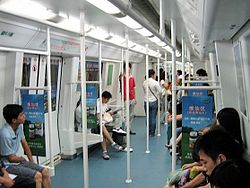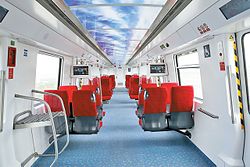Shenzhen Metro
The Shenzhen Metro (simplified Chinese: 深圳地铁; traditional Chinese: 深圳地鐵; pinyin: Shēnzhèn Dìtiě) is the rapid transit system for the city of Shenzhen in Guangdong province, China.
The Line 8 Extension - which opened on 27 December 2023 - put the network at 555.43 kilometres (345.13 miles) of trackage. It currently operates on 16 lines with 373 stations. Despite having only opened on 28 December 2004, the Shenzhen Metro is the 5th longest metro system in China and 6th longest in the world. By 2035, the network is planned to comprise of 8 express and 24 non-express lines totaling 1,142 kilometres (710 miles) of trackage.
| Shenzhen Metro | |||
|---|---|---|---|
 | |||
 | |||
| Overview | |||
| Locale | Shenzhen | ||
| Transit type | Rapid transit | ||
| Number of lines | 16: 1 2 3 4 5 6 6B 7 8 9 10 11 12 14 16 20 | ||
| Number of stations | 373 | ||
| Daily ridership | 5.99 million (2021) 8.4223 million (December 31, 2021 Record) | ||
| Annual ridership | 1.8775 billion (2018) | ||
| Website | SZMC (Shenzhen Metro Group) MTR Corporation (Shenzhen) (Chinese only) | ||
| Operation | |||
| Began operation | 28 December 2004 | ||
| Operator(s) |
| ||
| Technical | |||
| System length | 555.43 km (345.13 mi) | ||
| Track gauge | 1,435 mm (4 ft 8+1⁄2 in) standard gauge | ||
| Electrification | 1,500 V DC overhead catenary or third rail | ||
| Top speed |
| ||
| |||
| Shenzhen Metro | |||||||||||||
|---|---|---|---|---|---|---|---|---|---|---|---|---|---|
| Simplified Chinese | 深圳地铁 | ||||||||||||
| Traditional Chinese | 深圳地鐵 | ||||||||||||
| |||||||||||||
Current system
Currently the network has 555.43 kilometres (345.13 miles) of route, operating on 16 lines with 373 stations. Line 1, Line 4 and Line 10 run to the border crossings between the Shenzhen Special Economic Zone and the Hong Kong Special Administrative Region at Luohu/Lo Wu and Futian Checkpoint/Lok Ma Chau, where riders can transfer to Hong Kong's MTR East Rail line for travel onwards to Hong Kong.

Line 1

Line 1, formerly known as Luobao line, runs westward from Luohu to Airport East. Trains operate every 2 minutes during peak hours and every 4 minutes at other times. The line is operated by SZMC (Shenzhen Metro Group). Line 1's color is green.
- 28 December 2004: Luohu – Window of the World
- 28 September 2009: Window of the World – Shenzhen University
- 15 June 2011: Shenzhen University – Airport East
Line 2

Line 2, formerly known as Shekou line, runs from Chiwan to Liantang. Line 2 is connected with Line 8 at Liantang station. The line is operated by SZMC (Shenzhen Metro Group). Line 2's color is orange, the same as Line 8.
- 28 December 2010: Chiwan – Window of the World
- 28 June 2011: Window of the World – Xinxiu
- 28 October 2020: Xinxiu – Liantang
Line 3

Line 3, formerly known as Longgang line, runs from Futian Bonded Area to Shuanlong in Longgang, in the north-east part of the city. Construction began on 26 December 2005. The line is operated by Shenzhen Metro Line 3 Operations, which has been a subsidiary of SZMC (Shenzhen Metro Group) since 11 April 2011 when an 80% stake was transferred to SZMC. Line 3's color is sky blue.
- 28 December 2010: Caopu – Shuanglong
- 28 June 2011: Yitian – Caopu
- 28 October 2020: Futian Bonded Area – Yitian
Line 4

Line 4, formerly known as Longhua line, runs northward from Futian Checkpoint to Niuhu. Trains operate every 2.5 minutes at peak hours and every 6 minutes during off-peak hours. Stations from Futian Checkpoint to Shangmeilin Station are underground. The line has been operated by MTR Corporation (Shenzhen), a subsidiary of MTR Corporation, since 1 July 2010. Line 4's color is red.
- 28 December 2004: Fumin – Children's Palace
- 28 June 2007: Futian Checkpoint – Fumin
- 16 June 2011: Children's Palace – Qinghu
- 28 October 2020: Qinghu – Niuhu
Line 5

Line 5, formerly known as Huanzhong line, runs from Chiwan in the west to Huangbeiling in the east. Construction began in May 2009 and the line opened on 22 June 2011. Line 5 required a total investment of 20.6 billion RMB. The line is operated by SZMC (Shenzhen Metro Group). Line 5's color is purple.
- 22 June 2011: Qianhaiwan – Huangbeiling
- 28 September 2019: Qianhaiwan – Chiwan
Line 6
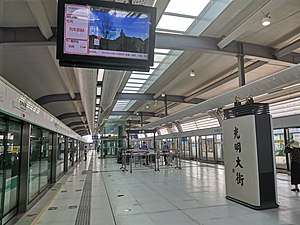
Line 6, formerly known as Guangming line, runs from Songgang in the north to Science Museum in the south, with a length of 49.4 km (30.7 mi) and a total of 27 stations. Construction began in August 2015 and the line opened on 18 August 2020. The line is operated by SZMC (Shenzhen Metro Group). Line 6's color is mint green.
- 18 August 2020: Science Museum – Songgang
Line 6 Branch

Line 6 Branch, also known as Branch Line 6, runs from Guangming to SIAT in the north. The line opened on 28 November 2022. Line 6 Branch's color is teal.
Line 7
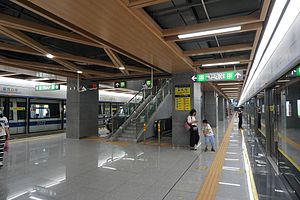
Line 7, formerly known as Xili line of the Shenzhen Metro, opened on 28 October 2016, with a length of 30.137 km (18.726 mi) and a total of 27 stations. It connects the Xili Lake to Tai'an. The line travels East–West across Shenzhen in a "V" shape. The line is operated by SZMC (Shenzhen Metro Group). Line 7's color is navy blue.
Line 8

Line 8, formerly known as Yantian line of the Shenzhen Metro, opened on 28 October 2020, with a length of 20.377 km (12.662 mi) and a total of 11 stations. It connects the eastern suburbs of Liantang to Yantian Road, then towards the beach resorts at Dameisha and Xiaomeisha. However, this line serves as the extension of Line 2 in actual operation. The line is operated by SZMC (Shenzhen Metro Group). Line 8's color is orange, the same as Line 2.
- 28 October 2020: Liantang – Yantian Road
- 27 December 2023: Yantian Road – Xiaomeisha
Line 9

Line 9, formerly known as Meilin line or Neihuan line of the Shenzhen Metro, opened on 28 October 2016. The line runs eastward from Qianwan to Wenjin. It has 10 transfer stations. The line is 36.18 km (22.48 mi) long, running through the districts of Nanshan, Futian and Luohu. The line is operated by SZMC (Shenzhen Metro Group). Line 9's color is grey brown.
- 28 October 2016: Hongshuwan South – Wenjin
- 8 December 2019: Qianwan – Hongshuwan South
Line 10
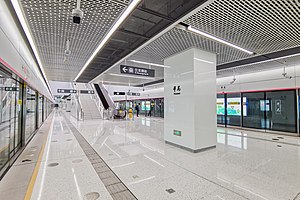
Line 10 formerly known as Bantian line, runs from Futian Checkpoint in the south to Shuangyong Street in the north, with a length of 29.3 km (18.2 mi) and a total of 24 stations. Construction began in September 2015 and the line opened on 18 August 2020. The line is operated by SZMC (Shenzhen Metro Group). Line 10's color is pink.
- 18 August 2020: Futian Checkpoint – Shuangyong Street
Line 11

Line 11, also known as the Airport Express, runs from Bitou in the northwest to Gangxia North in the city centre via Shenzhen Bao'an International Airport. Construction began in April 2012 and the line opened on 28 June 2016. Line 11 runs at a higher speed of 120 km/h (75 mph), however, the current line speed is limited to 80 km/h (50 mph). The line is operated by SZMC (Shenzhen Metro Group). Line 11's color is maroon.
- 28 June 2016: Bitou – Futian
- 28 October 2022: Futian – Gangxia North
Line 12

Line 12, also known as Nanbao Line, runs from Zuopaotai East in the southwest to Waterlands Resort East in the northwest. Construction began in 2018 and the line opened on 28 November 2022. Line 12's color is light purple.
- 28 November 2022: Zuopaotai East – Waterlands Resort East
Line 14

Line 14, also known as the Eastern Express, runs from Gangxia North in the city centre to Shatian in the northeast. Construction began in 2018 and the line opened on 28 October 2022. The line is operated by SZMC (Shenzhen Metro Group). Line 14's color is yellow.
- 28 October 2022: Gangxia North – Shatian
Line 16

Line 16, also known as Longping Line, runs from Universiade in the centre of Longgang to Tianxin in the northeast. Construction began in 2018 and the line opened on 28 December 2022. The line is operated by SZMC (Shenzhen Metro Group). Line 16's color is dark blue.
- 28 December 2022: Universiade – Tianxin
Line 20
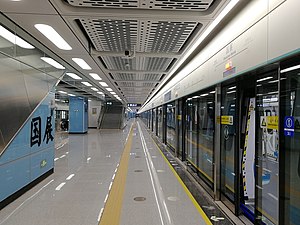
Line 20, formerly known as Fuyong line, runs from Airport North in the north-west to Convention & Exhibition City near Shenzhen World. Construction began in September 2016 and the line opened on 28 December 2021. Line 20 runs at the same top speed as line 11, at 120 km/h (75 mph). The line is operated by SZMC (Shenzhen Metro Group). Line 20's color is light blue.
- 28 December 2021: Airport North – Convention & Exhibition City
History

Early planning
In late 1983, Party Secretary of Shenzhen Mayor Liang Xiang led a team to Singapore to study its mass transit system. Upon returning it was decided that 30 metres (98 ft 5 in) on each side of Shennan Avenue should be protected as a green belt, and to set aside a 16-metre (52 ft 6 in) wide median reserved for a light rail or light metro line. In 1984, the "Shenzhen Special Economic Zone Master Plan (1985–2000)" pointed out that, with the growing population and traffic in Shenzhen, a light metro system would not have sufficient capacity to meet future demand. Instead the report proposed a heavy rail subway line to be built along Shennan Avenue. The project was finally approved by the Central Planning Department in 1992.
In August 1992, during and re-feasibility and rail network planning, The Shenzhen Municipal Government decided to move from building a light metro line to a heavy rail subway line. The rapid growth of Shenzhen City made a lower capacity light metro line impractical. In 1994, Shenzhen organized the preparation of the "Shenzhen urban rail network master plan" to be incorporated into the "Shenzhen City Master Plan (1996–2010)". The city's vision for an urban rail network would consists of nine lines. Of the nine transit lines, three of them would be commuter rail lines upgraded from existing national mainline railways. The total length of the proposed network would be about 270 km (170 mi). The three upgraded commuter rail lines would overlap the Guangzhou–Shenzhen railway, Pinghu–Nanshan railway and Pingyan railway. This plan established the basic framework for the Shenzhen Metro network.
Construction suspended and restarted
In December 1995, the State Council issued the "moratorium on approval of urban rapid transit projects" to suspend approval of rail transit projects in all Chinese cities except Beijing, Shanghai, and Guangzhou. The Shenzhen Metro project was postponed. In 1996, prior to the handover of Hong Kong, authorities attempted to restart construction by renaming the project "The Luohu, Huanggang / Lok Ma Chau border crossing passenger rail connection project", stressing that the project is designed to meet the potential growing demand for cross-border passenger traffic after the handover.
In 1997, Shenzhen reapplied its Subway plans to the State Planning Commission, and received approval in May 1998. The project was renamed the "Shenzhen Metro first phase". In July 1998, SZMC (Shenzhen Metro Group). was formally established. By April 1999, the subway project feasibility study report has been approved by the state.
Phase I (1998–2004)
Construction of the first sections of Line 1 and Line 4 began in 1999. The grand opening of the Shenzhen Metro system occurred at 5:00 pm on Tuesday, December 28, 2004. This made Shenzhen the seventh city in mainland China to have a subway after Beijing, Tianjin, Shanghai, Guangzhou, Dalian and Wuhan.
Initially the trains operated at 15-minute frequencies and consisted of Line 1 services between Luohu and Shijie Zhi Chuang (now Window of the World) and the Line 4 services between Fumin and Shaonian Gong (now Children's Palace). Initially the English names of the stations were rendered in Hanyu Pinyin, but some of the names were changed to English translation with American spelling in mid-2011.
The Futian Checkpoint station opened on 28 June 2007 using the name Huanggang.
| Date Opened | Line | Termini | Length in km | Stations | |
|---|---|---|---|---|---|
| 28 December 2004 | – phase 1 | Luohu | Window of the World | 17.4 | 15 |
| – phase 1 (initial section) | Fumin | Children's Palace | 3.4 | 4 | |
| 28 June 2007 | – phase 1 (extension) | Futian Checkpoint | Fumin | 1.1 | 1 |
Name changes
On April 23, 2008, Shenzhen Municipal Planning Bureau announced that it would change the nomenclature of Shenzhen's subway lines according to the "2007 Urban Rail Transit Plan Scheme". Instead of using numbers as the lines official designation, as typically used in other mainland Chinese metro systems, lines would be given Chinese names more akin to the Hong Kong MTR. In 2010, the Scheme was reviewed and adjusted with new routes and names in addition to newly proposed lines. On 23 October 2013, the SZMC (Shenzhen Metro Group) decided that current operational lines will have their number and names combined, while future lines will only be numbered. Due to the change in the construction order of several lines, some numerical names have been reviewed in order to prevent big jump between numbers. By 2016, only numerical names are used.
Lines currently in operation:
| Original No. | 2007 Scheme | 2010 Scheme | Current name |
|---|---|---|---|
| Line 1 | Luobao Line | Luobao Line (Line 1) | Line 1 |
| Line 2 | Shekou Line | Shekou Line (Line 2) | Line 2 |
| Line 3 | Longgang Line | Longgang Line (Line 3) | Line 3 |
| Line 4 | Longhua Line | Longhua Line (Line 4) | Line 4 |
| Line 5 | Huanzhong Line | Huanzhong Line (Line 5) | Line 5 |
| Line 7 | Xili Line | Xili Line (Line 7) | Line 7 |
| Line 8 | Yantian Line | Yantian Line (Line 8) | Line 2 Extension (Line 8 Phase 1) |
| Line 9 | Neihuan Line | Meilin Line (Line 9) | Line 9 |
| Line 16 | Pinghu Line | Bantian Line (Line 16/Line 10) | Line 10 |
| Line 11 | Airport Line | Airport Line (Line 11) | Line 11 |
| Line 10 | Bao'an Line | Nanbao Line (Line 10/Line 12) | Line 12 |
| Line 14 | Eastern Express | Eastern Express (Line 14) | Line 14 |
| Line 12 | Pingshan Line | Longping Line (Line 12/Line 16) | Line 16 |
| - | - | Fuyong Line (Line 20) | Line 20 (International Expo Conveyance Project) |
Lines under construction:
| Original No. | 2007 Scheme | 2010 Scheme | Current Name |
|---|---|---|---|
| Line 15 | Shiyan Line | Shiyan Line (Line 15/Line 13) | Line 13 |
Phase II (2007–2011)
From 2004 to 2007, there was a lack of official government interest and attention to expanding the subway after completion of Phase 1 with little or no active projects. Subway construction speed was ridiculed as "earthworm speed". On 17 January 2007 Shenzhen won the right to host the 2011 Universiade. In the bid Shenzhen committed to complete 155 km (96 mi) of subway lines before the games. The mayor of Shenzhen at the time, Xu Zongheng, sharply criticized the speed and efficiency of Shenzhen's subway construction procedures and calls for reform. Subsequently, the Shenzhen municipal government and various departments signed a liability form, requiring Phase II subway expansion to be completed in time for the Universiade. Shenzhen Metro increased to over a hundred operating metro stations in June 2011, just before the Shenzhen Universiade games. In the span of two weeks, the network expanded from 64 km (40 mi) to 177 km (110 mi). This expansion increased rail transit's share of total public transit trips from 6% to 29% in 2014.
| Date Opened | Line | Termini | Length in km | Stations | |
|---|---|---|---|---|---|
| 28 September 2009 | – phase 2 (trial) | Window of the World | Shenzhen University | 3.39 | 3 |
| 28 December 2010 | – phase 1 | Chiwan | Window of the World | 15.1 | 12 |
| – phase 1 (elevated section) | Shuanglong | Caopu | 25.6 | 16 | |
| 15 June 2011 | – phase 2 | Shenzhen University | Airport East | 23.6 | 12 |
| 16 June 2011 | – phase 2 (first north extension) | Children's Palace | Qinghu | 15.9 | 10 |
| 22 June 2011 | – phase 1 | Qianhaiwan | Huangbeiling | 40.0 | 27 |
| 28 June 2011 | – phase 2 (first east extension) | Window of the World | Xinxiu | 20.65 | 17 |
| - phase 1 (underground section) & phase 2 (first south extension) | Caopu | Yitian | 16.52 | 14 | |
Phase III (2012–2023)
In 2010, the Shenzhen Urban Planning and Land Resources Committee proposed a building program (Phase III) between 2011 and 2020. In 2011 this plan was approved by the NDRC. Phase III formally commenced in May 2011 with an expected cost of 125.6 billion yuan. It will cover Lines 6, 7, 8, 9, and 11 and will extend the length of the Shenzhen Metro to 348 kilometres (216 mi) and 10 lines. In June 2011, the Shenzhen Urban Planning and Land Resources Commission started gather public input on Phase III station names. On June 28, 2016, Line 11 opened being the first subway line in Shenzhen with 8 car trains and 120 km/h (75 mph) maximum service speed and the first in China with a First Class service. Lines 7 and 9 followed on October 28, 2016. South extension of Line 5 opened on 28 September 2019 and west extension of Line 9 opened on 8 December 2019. Line 6 and Line 10 opened on 18 August 2020 bringing the length of the Shenzhen Metro to 382.1 km (237.4 mi) and the fourth longest in China. Second east extension of Line 2, second south extension of Line 3, second north extension of Line 4 and phase 1 of Line 8 opened on 28 October 2020 bringing the length of the Shenzhen Metro to 411 km (255 mi).
| Date Opened | Line | Termini | Length in km | Stations | |
|---|---|---|---|---|---|
| 28 June 2016 | – phase 1 | Futian | Bitou | 51.936 | 18 |
| 28 October 2016 | – phase 1 | Tai'an | Xili Lake | 30.173 | 28 |
| – phase 1 | Wenjin | Hongshuwan South | 25.38 | 22 | |
| 28 September 2019 | – phase 2 | Qianhaiwan | Chiwan | 7.65 | 7 |
| 8 December 2019 | – phase 2 | Hongshuwan South | Qianwan | 10.79 | 10 |
| 18 August 2020 | – phase 1 & 2 | Science Museum | Songgang | 49.4 | 27 |
| Futian Checkpoint | Shuangyong Street | 29.3 | 24 | ||
| 28 October 2020 | – phase 3 (second east extension) | Xinxiu | Liantang | 3.82 | 3 |
| – phase 3 (second south extension) | Yitian | Futian Bonded Area | 1.5 | 1 | |
| – phase 3 (second north extension) | Qinghu | Niuhu | 10.791 | 8 | |
| – phase 1 | Liantang | Yantian Road | 12.367 | 7 | |
| 27 December 2023 | – phase 2 | Yantian Road | Xiaomeisha | 8.01 | 4 |
Phase IV (2017–2025)
With the shortening of the Phase III implementation period, a number of lines (Lines 16 and 12) planned in 2007's Phase III moved into the next phase. By 2016, it was determined that Phase IV will have an implementation period between 2017 and 2022 and consist of 274 km (170 mi) of new subway. Lines 13 and 14 which originally had a long term 2030 completion deadline were moved into Phase IV expansion. In addition, a branch line of Line 6 will connect with the neighboring Dongguan Rail Transit system. Lines 12, 13, 14, and 16 and branch of Line 6 was approved by the NDRC in July 2017 and started construction in January 2018.
| Date Opened | Line | Termini | Length in km | Stations | |
|---|---|---|---|---|---|
| 28 October 2022 | - phase 1 | Gangxia North | Shatian | 50.3 | 17 |
| 28 November 2022 | - phase 1 | Guangming | SIAT | 6.13 | 4 |
| - phase 1 | Zuopaotai East | Waterlands Resort East | 40.54 | 33 | |
| 28 December 2022 | - phase 1 | Universiade | Tianxin | 29.2 | 24 |
Phase IV revised expansion (2020–2025)
The first phase of Line 20 was fast tracked from Phase IV to provide a shuttle between Line 11 and a new International Convention Center, now called Convention & Exhibition City. The construction started in September 2016, but as for early 2019, the construction is paused because the Development and Reform Commission did not approve the project. The Phase IV revised plan approved by the NDRC on March 26, 2020, approved the first Phase of Line 20 allowing for construction to continue. The line eventually opened on 28 December 2021. Futian to Gangxia North in the first section of Phase 2 of Line 11 opened on 28 October 2022.

| Date Opened | Line | Termini | Length in km | Stations | |
|---|---|---|---|---|---|
| 28 December 2021 | - phase 1 | Airport North | Convention & Exhibition City | 8.43 | 5 |
| 28 October 2022 | - phase 2 (trial) | Futian | Gangxia North | 1.6 | 1 |
Future expansion
Phase IV expansion
| Expected opening | Line | Section | Terminals | Length in km | Stations | |
|---|---|---|---|---|---|---|
| 28 October 2024 | 13 | Phase 1 South | Shenzhen Bay Checkpoint | Hi-Tech Central | 22.45 | 7 |
| 2025 | 13 | Phase 1 North | Hi-Tech Central | Shangwu | 9 | |
Phase IV Revised Expansion
The Phase IV revised plan approved by the NDRC on March 26, 2020, added a number of extension projects.
| Expected opening | Line | Section | Terminals | Length in km | Stations | |
|---|---|---|---|---|---|---|
| 2024 | 3 | Phase 4 | Shuanglong | Pingdi Liulian | 9.35 | 7 |
| 7 | Phase 2 | Xili Lake | Xuefu Hospital | 2.45 | 2 | |
| 2025 | 6B | South extension | Guangmingcheng | Guangming | 4.9 | 3 |
| 8 | Phase 3 | Xiaomeisha | Xichong | 4.26 | 1 | |
| 11 | Phase 2 | Gangxia North | Hongling South | 4.39 | 3 | |
| 12 | Phase 2 | Waterlands Resort East | Songgang | 8.16 | 5 | |
| 13 | Phase 2 | Shangwu | Gongming North | 18.8 | 11 | |
| 16 | Phase 2 | Universiade | Xikeng | 9.53 | 8 | |
| 2026 | 13 | South extension | Shenzhen Bay Checkpoint | Dongjiaotou | 4.47 | 3 |
Miscellaneous
Line 5 west extension is part of Phase II expansion.
| Expected opening | Line | Section | Terminals | Length in km | Stations | Phase | |
|---|---|---|---|---|---|---|---|
| 2025 | 5 | West extension | Huangbeiling | Grand Theater | 2.87 | 3 | II |
Phase V (2023-2028)
In the Shenzhen Metro 2007 masterplan proposed four more lines (Lines 13, 14, 15 and 16) which have a planned completion target of 2030. In 2016, all aforementioned lines but Line 15 were designated as part of the Phase IV expansion, moving the completion date forward from 2030 to 2022. In 2012, four further lines Qiannan (Line 17), Pinghu (Line 18), Pingshan (Line 19) and Fuyong (Line 20) where unveiled, making the total planned length of the Shenzhen Metro to 720 km (447 mi) spread out over 20 lines. The first phase of Line 20 was fast-tracked and included in the Phase III revised expansion with a completion date of 2018. This leaves Line 15, 17-19 and the rest of Line 20 available for the next phase (Phase V) of subway expansion. In September 2022, the Shenzhen municipal government confirmed the projects proposed to be included in its phase V expansion. A total of 227 km (141 mi) of new lines are proposed.
On March 31, 2023, the Bureau of Housing and Urban Rural Development of Shenzhen Metro Municipality will open the bidding for the fifth phase planning of Shenzhen Metro Metro, including Line 15, Line 17 Phase I, Line 19 Phase I, Line 20 Phase II (Airport East—Baishizhou), Line 22 Phase I, Line 25 Phase I, Line 27 Phase I, Line 29 Phase I and Line 32 Phase I, This means that these 9 lines have been approved with an investment amount of 191.1 billion yuan. However, Line 18 Phase I, Line 21 Phase I, Line 10 East Extension (Shenzhen Section) and Metro Line 11 North Extension (Shenzhen Section), which were previously proposed to be included in the fifth phase plan of Shenzhen Metro, were not included in this announcement.
In June 2023, the Fifth Phase Construction Plan of Shenzhen Urban Rail Transit (2023-2028) has been approved for a total of 11 construction projects, including Line 15, Line 17 Phase I, Line 19 Phase I, Line 20 Phase II (Airport East—Baishizhou), Line 22 Phase I, Line 25 Phase I, Line 27 Phase I, Line 29 Phase I, Line 32 Phase I, Line 10 East Extension (Shenzhen Section) and Metro Line 11 North Extension (Shenzhen Section). On 28 June 2023, Shenzhen Metro Line 15 started construction, followed by Line 17 Phase I and Line 20 Phase II on 10 October 2023, Line 22 Phase I on 2 January 2024 and Line 25 on 26 February 2024. Other construction projects will start in 2024.
| Line | Section | Terminals | Length in km | Stations | |
|---|---|---|---|---|---|
| 10 | East extension | Shuangyong Street | Huanggekeng | 9.8 (2.9 in Shenzhen) | 5 (1) |
| 11 | North extension | Bitou | Chang'an | 3.7 (0.8 in Shenzhen) | 1 (0) |
| 14 | West extension | Gangxia North | Xiangmihu West | 1 | |
| 15 | Loop Line | 32.2 | 24 | ||
| 17 | Phase 1 | Luohu West | Shanglilang | 18.8 | 18 |
| 19 | Phase 1 | Nantangwei | Julong | 12.5 | 12 |
| 20 | Phase 2 | Airport North | Baishizhou | 24.9 | 11 |
| 20 | Phase 2.5 | Baishizhou | Futian Convention & Exhibition Centre | 3 | |
| 22 | Phase 1 | Shangsha | Liguang | 34.2 | 21 |
| 25 | Phase 1 | Shilong | Jihua Hospital | 16.2 | 14 |
| 27 | Phase 1 | Songpingcun | Gangtou West | 23.2 | 19 |
| 29 | Phase 1 | Hongshuwan South | Xingdong | 11.3 | 10 |
| 32 | Phase 1 | Xichong | Kuichong East | 9.5 | 5 |
| Total | 196.3 | 140 | |||



